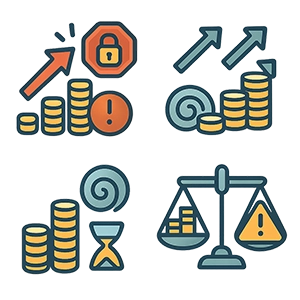A sports betting system in Britain explains structured wagering strategies combining probability, bankroll control, and discipline. It covers fixed or progressive staking, exchanges, and sport-tailored methods. Systems operate under UK Gambling Commission compliance, highlighting legal safeguards. Clear tools, responsible frameworks, and accurate performance tracking shape sustainable gambling practices across regulated markets.
Betting System Bookies
Readers often mix systems with entertainment products, yet online betting casino games UK sit in a different lane entirely and shouldn’t be used as performance benchmarks for sport.
FAQs — what is a sports betting system and common terms
| Question | Answer |
| What exactly is a “system”? | A repeatable rule-set for selecting prices and sizing stakes. It lives on written criteria, not gut feeling. Good ones specify markets, entry thresholds, and record every wager so performance can be audited without hindsight. |
| Is using one legal in the UK? | Yes, when you bet with licensed operators and follow their terms. Regulation focuses on fair conduct, identity checks, and responsible limits. Method is allowed; misuse, deception, or breaching platform rules is not. |
| Can any approach guarantee profit? | No. Claims of certainty ignore limits, liquidity, and variance. If someone promises risk-free returns, treat it as advertising, not evidence. Ask for long samples, timestamps, and independent verification before believing anything. |
| How big should my bankroll be? | Ring-fence money you can lose, then define a unit as 1–2% of that pot. Size protects you from streaks and stops one weekend erasing months of work. Increase stakes only after documented growth. |
| Do accumulators fit structured methods? | They can, if rules demand a price edge on each leg and a cap on liability. Parlays amplify variance; use sparingly, with strict limits, and keep records showing whether combos beat singles over time. |
| Are bots or scrapers allowed? | Only when the operator explicitly permits them. Many sites ban automated order firing or bulk data harvesting. If tools break house rules, expect restrictions or closure regardless of intent or results. |
| What about “chasing” losses? | Escalation schemes raise stakes after defeats. They fail when limits, liquidity, or nerves intervene. Recovery looks tidy on paper, then collapses under a long run of losers. Flat or percentage staking is safer. |
| How should I judge offers and guides? | Search for a sports betting system review that shows logs, entry prices, and closing marks. Without raw data, you are buying a story. Demand samples across seasons, not a handful of screenshots. |
| Are refunds or “money-back” promos reliable edges? | Occasionally, but only when terms are favourable and limits don’t neuter stakes. Track them separately and include declined or partially paid outcomes so the ledger reflects reality, not the best-case narrative. |
| What records do I need? | Date, event, market, odds, stake, rationale, result, and closing price. Add notes on delays, rejections, or cancellations. Clean data turns hindsight into analysis and shows whether price selection truly beats the crowd. |
What does a sports betting system mean?

In the UK, a system sports betting framework means rule-driven wagering that prioritises consistency, evidence, and accountability. Activity runs on sportsbooks and exchanges, with prewritten criteria filtering markets, setting entry thresholds, and defining stake sizing. Unlike tip-led hunches, processes stay testable, repeatable, and transparent, because every selection is recorded, timed, and later evaluated. Scope covers single wagers plus structured plays where multiple legs follow probability rules rather than guesswork. Prices use domestic formats, so practitioners translate quotes quickly and compare availability before acting. Documentation matters as much as execution, since clean logs reveal fatigue, errors, and edge decay. Governance also counts: regulated operators publish settlement standards, while exchanges publish matching mechanics. The purpose is discipline, not promises; by enforcing limits, triggers, and reviews, a framework protects bankroll health and decision quality. With that orientation established, readers can explore definitions, mechanics, and evaluation through a concise, UK-centred lens. Tool choice matters too; a sports betting app ios android that logs rules cleanly will save hours and reduce selection errors.
Expert opinions
Quantified rules turn variance into information, letting bettors evaluate edges honestly.
Rufus Peabody, professional bettor and Unabated co-founder, focused on regulated British markets LinkedIn.com
Structured logging, model calibration, and disciplined staking separate luck from skill.
Dan Weston, analyst and trading specialist, active across cricket and tennis LinkedIn.com
That discipline underpins responsible sports betting UK, where process beats impulse and records keep you honest.
Understanding the difference between a betting system, strategy, arbitrage and trading model
Clear distinctions prevent costly mistakes. A system uses explicit rules that dictate selections and stakes; results remain auditable across long samples. A strategy gives broader guidance, describing principles without mandating fixed triggers. An arbitrage betting system exploits opposing prices to lock tiny margins regardless of outcome. A trading model treats positions like assets, targeting profit from moves between back and lay quotes rather than final results. In Britain, examples help. A value hunter might back an underdog when a model shows mispricing, while a trader exits early after a sharp drift. Marketing often muddies language, promising miracles with vague claims. Serious practitioners reject hype by defining logic, tracking execution, and measuring expectation. Testability remains the decisive filter, because repeatable methods withstand scrutiny and noisy anecdotes do not. Price gaps invite caution; arbitrage betting UK sounds simple, yet practical limits, timing, and account reviews bite hard.
- Betting system: Fixed, rule-based mechanics controlling selection and staking, applied consistently, recorded diligently, reviewed periodically for drift.
- Betting strategy: Guiding principles shaping markets targeted, time horizons, and risk tolerance, without strict entry or exit triggers.
- Arbitrage betting: Opposing wagers across operators exploit price gaps to crystallise modest gains before results conclude, subject to limits and timing.
- Trading model: Dynamic back-lay management on exchanges, with entries and exits capturing movement rather than outcome resolution.
All core elements: odds, bet selection, staking and bankroll discipline
Four pillars govern consistent practice. Odds anchor evaluation, because implied probability conversion turns prices into comparable percentages, exposing genuine value or hidden risk. Selection quality depends on context, modelling, and timing; weak filters sabotage edges before staking even begins. Staking translates conviction into exposure, with level, proportional, or capped approaches shaping volatility through wins and losses. Discipline protects capital by enforcing limits, resisting tilt, and maintaining records that reveal variance rather than emotion. Each pillar influences the others: poor entry destroys good staking; lax records mask problems; sloppy timing erases advantage. A small error repeated across many events compounds quickly, degrading performance that once appeared promising. Resilient frameworks therefore prioritise clarity, execution hygiene, and review cycles, ensuring improvements persist while mistakes fade under corrective processes. Live markets demand a mapped in play betting strategy, tested when tempo shifts and liquidity thins.
- Odds: Convert quotes into percentages, compare against forecasts, and ignore noise when alignment falls short of a defined threshold.
- Bet selection: Apply filters, cross-check data sources, and confirm signal stability before submitting any order to a market.
- Staking: Predefine amounts, cap exposure during drawdowns, and avoid chases by automating stake rules where feasible.
- Bankroll discipline: Set limits, pace activity, and audit results weekly so trends become visible early and controllable, using honest, independent peer review.
How a betting system works
Anyone asking how to make a sports betting system must understand the entire path from market scan to settlement. The process begins with sourcing markets, evaluating available prices, and applying predefined rules. A punter then executes trades on a sportsbook or through an exchange. Bet settlement rules and voids affect the outcome, with final logging ensuring records remain complete. When you create sports betting system models, recognising execution differences between platforms becomes vital. Sportsbooks impose house-set lines, while exchanges operate peer-to-peer, influenced by liquidity and matching mechanics. Accurate record keeping validates consistency, highlighting whether a chosen method sustains value or falls short.
| Platform | Execution Method | Key Features |
| Sportsbook | House offers prices | Fixed margins |
| Exchange | Peer-to-peer matching | Market liquidity |
| Sportsbook | Immediate bet acceptance | Operator control |
| Exchange | Orders queued | Variable fills |
| Sportsbook | Settlement by operator | Standardised rules |
Cashflow timing matters as well; many readers favour betting sites fast withdrawal to keep admin friction low between review cycles.
Inputs that drive systems: data, markets, prices and constraints
Reliable frameworks depend on clean inputs. An algorithm sports betting system filters events by data quality, odds, and constraints. Sports betting system design begins with statistical databases, including form, injuries, and situational adjustments. Market selection prioritises competitions with liquidity and stability. Price filters assess opening line movement analysis and closing figures, reducing variance from volatile conditions. Constraints stem from bookmaker restrictions, stake caps, or exchange commission rates, requiring adjustments in stake sizing. Sharp vs soft bookmakers further influence access to accurate pricing. Without disciplined input management, outputs become unreliable, undermining edge validation.
- Team data: Recent form, player status, modelled projections.
- Market choice: Competitions with stable liquidity.
- Price filters: Spot misaligned odds via opening line movement analysis.
- Constraints: Book limits, maximum stake caps, or withdrawal terms.
- Exchange factors: Commission rates shaping profitability.
- Bookmaker quality: Sharp vs soft operators influencing accuracy.
Model overlays may include sports betting tips ai predictions, but only as one signal among many, never the driver.
Process & execution: rules that trigger a bet and how they work
A rule-based approach defines action. An automatic sports betting system operates through conditional statements, ensuring execution follows logic rather than impulse. A sports betting system builder specifies trigger grammar: IF a condition is met THEN stake X at minimum price Y. Pre-match conditions allow more preparation, while in-play trading ladder mechanics demand speed. Human checks reduce automation risks, avoiding errors from mispriced feeds or malfunctioning scripts. Cash out and hedging options further refine execution, granting flexibility if variance shifts dramatically. Recording each outcome maintains transparency and enables performance audits, proving whether triggers achieve sustainable impact or require revision.
- Trigger definition: Specific conditions such as odds thresholds.
- Stake sizing: Proportional amounts tied to bankroll.
- Execution timing: Pre-match or in-play dynamics.
- Safety checks: Human validation prevents malfunction.
- Adjustment tools: Cash out and hedging provide flexibility.
Ignore any pitch promising a zero risk betting strategy; variance and limits ensure risk never reaches zero.
UK legalities & limits
In Britain, betting systems themselves are not outlawed. What matters is how they are used and where. Licensed sportsbooks and exchanges allow punters to record rules, test models and keep logs. That activity stays legal so long as it runs through operators holding UK Gambling Commission compliance. Where problems start is with automation: bots scraping odds or firing rapid bets breach site terms and often lead to account closure. Personal spreadsheets and manual record-keeping are fine; automated scraping of data feeds is not. Customers should remember that UK law protects transparency. Operators are obliged to apply settlement rules fairly, publish limits clearly, and handle disputes independently. So, the system is never judged by style but by whether it stays inside licensed platforms and follows agreed rules. Note: grey-market esports skin betting raises separate concerns and does not sit within licensed UK frameworks.
Expert opinions
Consumers can use structured staking or tracking tools freely, provided they do so on licensed sites.
Tim Miller, Executive Director, UK Gambling Commission LinkedIn.com
When bots or scraping are deployed without consent, enforcement follows quickly.
Sarah Gardner, Deputy Chief Executive, UK Gambling Commission LinkedIn.com
For everyday safeguards, lean on responsible sports betting tips UK such as deposit caps, time-outs, and periodic audits.
Regulation, safer gambling, KYC and limits that protect all bettors
Checks and limits define modern gambling in the UK. A bankroll management sports betting system may help punters plan, but compliance tools set the boundaries. Licensed firms must verify identity, run kyc and source of funds checks, and step in when patterns suggest financial strain. Affordability checks and stake limits stop play escalating too quickly. Customers can set deposit caps or use GamStop self-exclusion tools to block accounts nationwide. Where disputes arise, IBAS dispute resolution steps in. Together, these measures make up the best sports betting money management system in practice: oversight and self-control working side by side. Betting remains legal entertainment only when these protections are active.
- KYC checks: Proof of age and identity required before accounts open.
- Source of funds: Income evidence requested when spend passes set thresholds.
- Affordability checks: Limits imposed when data suggests risk of harm.
- GamStop exclusion: Nationwide blocking available on request.
- Deposit limits: Users set daily, weekly or monthly maximums.
- Dispute resolution: IBAS reviews complaints independently.
Location tools even help newcomers find a bookies near me while staying inside licensed venues and safer-gambling guardrails.
Terms that affect systems: arbitrage, matched betting, trading and bot use
Arbitrage sports betting systems exploit price gaps across firms. While not unlawful, most bookmakers restrict or close accounts when these patterns appear. Matched betting follows a similar path: it is legal but often flagged as bonus abuse. Exchange trading is permitted, though exchange commission rates eat into margins. Progression staking, where bets rise after losses, sits under operator scrutiny because of higher volatility. A sports betting tipping system bought from third parties may also clash with advertising rules. All these practices fall under terms and conditions, which include clauses on gubbing and account restrictions, bet settlement rules and voids, and automated play. Systems may be smart, but contracts decide their survival.
- Arbitrage: Price exploitation quickly leads to stake reductions or bans.
- Matched betting: Promo restrictions cut access when patterns repeat.
- Exchange trading: Allowed, but fees and latency influence profit.
- Progression staking: Risk triggers operator alerts for unusual activity.
- Tipping services: Advertising controls apply to paid tip providers.
- Automation: Bots without consent breach terms and close accounts.
Separate exchange activity that uses a crypto sports betting exchange; fees, volatility, and onboarding rules change the maths.
Bankroll strategy explained
Bankroll size dictates survival more than any hot tip. Using a sports betting units system brings order by dividing the pot into measured stakes. A unit system sports betting method converts variance into predictable exposure, lowering risk of ruin and clarifying return on investment. Ignore social hype around the latest betting challenge UK unless rules, risk limits, and logs are public and testable. Unit size calculation frames every move, protecting capital while smoothing swings.
Bankroll sizing, unit stakes and stop-loss that keep variance tolerable
Success comes from structure. Bettors searching for the best money management system sports betting guides recommend starting with bankroll allocation. A small percentage of capital becomes one unit; usually 1–2% is sensible. This unit drives consistent staking, whether on football, tennis, or horse racing. For those looking for sports betting system for low bankroll, exposure must be capped even tighter. UK odds formats make illustration clear: £10 on 2/1 fractional or 3.0 decimal returns £30 gross. Without limits, variance erodes funds quickly. Risk of ruin calculator tools show how over-staking accelerates collapse. A daily stop-loss prevents chasing when variance turns against you, while a weekly stop-win locks in profit. Variance and ROI tracking keep records objective, proving whether a method works under stress.
- Size the bankroll: Reserve funds, e.g., £500 total.
- Define a unit: Use 1–2% stake, such as £10.
- Set stop-loss: Cap daily risk at 5–10% total funds.
- Apply stop-win: Pause when gains reach agreed target.
- Cap exposure: Limit active wagers to protect liquidity.
Small pots should start slow; shortlists of lowest deposit betting sites can keep experiments modest while you learn pacing.
Record-keeping, audit trails and understanding odds-based EV
Every system lives or dies on records. A sports betting system review without logs is just opinion. The best sports betting system review demands audit trails: date, market, stake, odds, outcome, and rationale. A bet tracking spreadsheet template delivers structure. Each line includes expected value (EV) calculator output and later comparison with closing line value (CLV). These figures are not guarantees but diagnostics; they measure decision quality rather than outcome luck. When post-mortems reveal consistent positive EV and CLV, confidence rises. Where gaps persist, rules need revision. The aim is accountability, not narrative. Numbers force honesty, exposing whether edge survives in real markets or vanishes once tested. Track formats separately as well; ask what is a daily fantasy sports bet when logging slates, late swaps, and unique scoring. In January 2026, with margins thinner than ever, proper records are the only proof that a method works.
- Date & market: Show when and where bet placed.
- Stake & odds: Confirm exposure and price used.
- EV estimate: Note expected value from models.
- CLV check: Compare entry odds with market close.
- Outcome & notes: Record result, context, and lessons.
Progressive betting systems

Escalating stakes has always carried appeal. The sports betting progression system promises recovery of losses or accelerated profit through mechanical escalation. It looks neat but hides fragile maths. Regression to the mean makes streaks inevitable, and operator limits cut escalation short. Any guaranteed sports betting system claim collapses when account ceilings and bankroll constraints collide. Systems must be judged by risk exposure, not headline attraction.
| System | Stake Path | Assumptions | Key Risk | Operator Limit Interaction |
| Martingale | Double after loss | Infinite bankroll | Rapid escalation | Max bet blocks sequence |
| Paroli | Double after win | Win streaks appear | Runs dry quickly | Stop rules cap chains |
| Fibonacci | Add prior stakes | Steady recoveries | Long drawdowns | Ceilings halt sequence |
| D’Alembert | Increase by one unit on loss | Balanced outcomes | Extended streaks drain roll | Limits restrict grind |
Promotions won’t rescue flawed escalation; chasing with mobile casino free bonuses UK muddies evaluation and spikes risk.
Martingale system — doubling stakes vs bookmaker limits
The martingale system sports betting method doubles every stake after a loss, assuming one win resets the chain. Applied to sport markets, it demands large reserves. A football bettor risking £10 at evens must stake £20 after a loss, then £40, £80, and so on. Within six defeats, exposure hits £640 to chase £10. Sports betting martingale system logic crumbles when affordability checks and stake limits intervene. Bookmakers cap maximum wagers, exchanges run liquidity short, and human nerves snap before theory plays out. Martingale betting system sports ideas ignore streak probability: even odds events can deliver eight losses in a row. That ruins a bankroll faster than recovery arrives. Mathematics insists variance stretches longer than intuition allows, making this approach unsuited to regulated environments where limits and checks govern activity.
Paroli (reverse martingale) — pressing wins without chasing losses
The paroli system sports betting approach flips martingale logic. Stakes rise after wins, not defeats. Punters press hot streaks while keeping base stakes low during lean spells. Typical structures stop after two or three successful escalations. For example, start with £10 at 2/1. If it wins, the next bet risks £20; another win risks £40. Once the sequence ends, profit is banked and the cycle restarts at £10. This framework fits plus-money markets where price magnifies outcomes. Confidence intervals for ROI demonstrate wide variance, because most sequences collapse early, but occasional streaks drive bursts of profit. It avoids catastrophic drawdowns, yet still requires discipline to reset after loss. The system attracts those preferring controlled aggression, but expectations must be tempered: variance dominates results, not design. Bonuses can sweeten starts, but the best signup bonus sports betting won’t fix poor entries or bad timing.
Fibonacci sequence — additive staking that feels safer but isn’t risk-free
The fibonacci sports betting system uses the classic sequence, where the next stake equals the sum of the two prior stakes. Losses prompt escalation; wins reset the chain. Example: a bettor starts at £10. A loss moves to £10 again, then £20, then £30. A single win recoups part of the sequence, but long losing runs still spiral exposure upward. The fibonacci system sports betting method appears less aggressive than martingale because increases are additive rather than exponential. Yet variance and ROI tracking shows drawdowns still bite. In practice, UK odds constrain the maths: prices must be above even money to make recoveries meaningful. Flat staking offers calmer swings; Fibonacci appeals to those seeking structure but provides no immunity from ruin. Its safety is illusion, its edge cosmetic.
Fixed & value-led systems

Fixed staking and value-based selection illustrate two contrasting but widely respected approaches. A proven sports betting system that uses flat amounts delivers stability. Every bet risks the same cash, regardless of price or confidence. The best betting system for sports rooted in value betting strategy goes further: stakes stay consistent, but picks only land when odds sit above assessed probabilities. This ensures long-run edge but demands accuracy. Fixed staking suits those prioritising smooth variance. Value-led models suit those who trust projections and can withstand lean runs. Both demand discipline with bankroll limits intact. Neither provides immunity from loss, but each builds a coherent framework anchored by rules, not emotion.
| System | Stake Path | Assumptions | Key Risk | Key Common Restrictions |
| Flat staking | Equal per bet | Edge repeats | Slow growth | Operator max bet caps |
| Value-led | Fixed unit on positive EV | Price efficiency | Misestimated edge | Line moves reduce entry |
| D’Alembert fixed | Add/subtract unit | Balanced outcomes | Long losing streaks | Stake ceilings enforced |
| Hybrid mix | Flat stake, value filter | Consistent model | Low volume | Liquidity constraints |
Keep selection rules tight; sprinkle tests with esports betting predictions only when they pass validation on fresh data.
Flat staking — simple system that suits most sports
A simple sports betting system built on flat staking risks the same amount every time. This easy sports betting system works across football, racing, and American leagues, because variance does not dictate stake. The flat staking plan helps beginners avoid ruin through overexposure. For example, risking £10 each bet on Premier League matches ensures predictable drawdowns. The main strength is control: no single match wipes out the roll. Weakness comes from missed upside when confidence is high, since stakes never flex. Guidance is straightforward: define a unit as 1–2% of bankroll, and scale slowly only when bankroll rises meaningfully. That steadiness makes it suitable for learners or anyone wanting calmer variance. If you’re busy on weekends, plan a flat-stake routine around fixtures; spare time is better than hurried guesses, especially alongside snooker betting tips that use slower markets.
Kelly Criterion & percentage staking — allocating bets to estimated edge
The kelly criterion sports betting framework calculates stake size based on estimated edge. A fractional Kelly approach tempers aggressiveness, cutting theoretical exposure in half. Percentage-of-bankroll methods simplify the logic, staking fixed percentages without precise edge input. Kelly criterion staking maximises growth in theory but punishes misestimation heavily. Confidence intervals for ROI remind users that projections carry error; conservative fractions reduce downside. Flat staking avoids misestimation risk but ignores edge size. When comparing the best sports betting system for staking, Kelly works for those with robust modelling, while percentage methods suit those preferring rules with less complexity. Each method asks bettors to choose between precision, risk tolerance, and variance acceptance.
| Method | Inputs Needed | Pros | Cons | Suitable For |
| Kelly Criterion | Estimated edge, odds | Maximises growth | Sensitive to errors | Advanced model users |
| Percentage staking | Bankroll size | Simple, scales automatically | Ignores true edge | Practical mid-level users |
| Flat staking | Unit defined | Stable exposure | Slow growth, no edge scaling | Beginners, casual bettors |
Motor racing models use sector times and degradation curves; fold those into cautious f1 betting tips before sizing with fractional Kelly.
Exchange & trading systems

Betting exchanges reshape markets by letting punters trade with one another rather than house odds. Unlike sportsbooks, the book is an open ledger of offers waiting to be matched. A sports live betting system adapts differently here because liquidity fluctuates. Commission applies on net wins, shaving percentages from margins. Order depth shows where buyers and sellers queue, making execution timing vital. A system play sports betting approach on exchanges thrives only when liquidity is high enough to fill orders. Thin markets risk partial matches or rejected stakes. Transparency benefits sharp users, but discipline is essential since prices shift fast. Niche markets grow fast, including crypto esports betting UK, but spreads, commission, and coin rails change the calculus.
Back-to-lay and lay-to-back trading — how price moves work
Back-to-lay means backing at a high price then laying lower, banking profit on contraction. Lay-to-back flips the logic: laying at short odds then backing bigger later. A sports betting system and expert picks framework can include these mechanics, but outcomes depend on reading flow correctly. Sports betting investment system models track opening line movement analysis and adjust orders on ladders. A horse drifts pre-off from 2/1 (3.0) to 3/1 (4.0); a punter laying at 3.0 then backing at 4.0 locks gain. Lay betting on exchanges rewards sharp entry and disciplined exit. Slippage and unmatched orders remain constant hazards. Traders must recognise risk: movement may stall, leaving exposed positions without offset.
| Setup | Entry | Exit | Profit Driver |
| Back-to-lay | Back high odds | Lay lower odds | Price shortens |
| Lay-to-back | Lay short odds | Back higher odds | Price drifts |
| Scalp | Back/lay tiny ticks | Close quickly | Micro moves |
| Swing trade | Hold longer | Exit at peak | Large shifts |
Some traders pair ladders with an esports betting guide, then paper-trade micro-moves before risking cash.
In-play trading — reading momentum, liquidity and odds drift
An inplay sports betting system lives or dies on real-time reaction. Football, tennis, and cricket markets swing violently with goals, breaks, or wickets. A sports live betting system must watch pace, possession, and injury stoppages. Liquidity often thins after shocks, so execution risk grows. Using an in-play trading ladder exposes prices as they move tick by tick. Cash out and hedging options manage positions but cost margin. Odds comparison and line shopping across books and exchanges highlight where edges exist. The challenge remains speed: latency punishes hesitation, while impulsive reactions magnify mistakes. Consistency and fast exits turn chaos into structure.
- Tempo shifts: Sudden pace increases signal volatility, e.g., late football surges.
- Possession swings: Tennis rallies or extended service holds alter price balance quickly.
- Injury breaks: Timeouts reset rhythm, driving liquidity out of markets.
- Market depth: Shallow ladders make large stakes difficult to unload.
- Cash-out checks: Partial hedging protects positions but reduces potential returns.
- Exit discipline: Pre-set triggers avoid chasing drift beyond manageable exposure.
Latency is brutal during live betting esports counter strike 2, where pauses, map swaps, and timeouts whipsaw ticks.
Sports-specific applications
Context shapes how a system works. Football throws off frequent data points, but sample sizes per team remain small. Racing delivers vast cards, yet form depth varies across tracks and classes. Both sports feature unique prop markets and player specials that colour prices. A sports betting underdog system may apply differently in each, while system plays sports betting frameworks must adapt to market structure and settlement rules. UK bettors need sport-aware design, not one-size-fits-all logic.
Horse racing systems — form, going, pace, each-way and place betting
British racing requires attention to granular detail. Form lines highlight recent performance, while going descriptions dictate suitability to surface. Draw and pace maps shape positional advantages, especially on tight tracks. A bankers system sports betting method can focus on standout horses in low-grade fields, whereas a sports betting money line system adapts to win/place formats on betting exchanges. Timing matters: some punters attack early markets, while others wait for Betfair Starting Price (BSP). Each way betting explained through structured filters — such as class drops, trainer strike rates, or jockey bookings — helps refine risk. Betting exchange liquidity impacts execution, especially in lower grades. Opening line movement analysis shows when smart money signals an angle, though liquidity can disguise intent. A disciplined filter set converts raw data into actionable triggers. Caution: no factor guarantees profit, but combined criteria raise strike-rate consistency.
| Factor | Why it matters | Typical filter | Market impact | Caveat |
| Form lines | Indicates current ability | Top-three finish last two starts | Shortens odds | Small fields exaggerate form |
| Going | Surface conditions affect stride | Soft-ground win record | Market reacts to rain | Late changes mislead |
| Draw | Position matters at tight tracks | Inside draw on sprints | Early move in prices | Track bias shifts |
| Pace maps | Shape of race influences finish | Front-runner bias | Influences each-way options | False pace scenarios |
| Trainer form | Stable confidence drives support | Last 14-day strike-rate above 20% | Attracts money | Small stable variance high |
| Class drops | Lower grade improves chance | Horse down one class | Sharp support | Hidden fitness issues |
Football systems — BTTS, unders/overs and that sample size problem
Football models wrestle with limited observations. A side plays 38 league matches a season, so over under goals model estimates lack depth. Poisson distribution football model logic helps, but regression to the mean punishes short-term trends. System triggers often centre on Both Teams to Score (BTTS) and totals markets. Filtering underdog prices for edge can add value, though variance remains high. NBA betting system sports strategy insights stress volume, while best mlb sports betting system research values longer schedules. Football lacks such depth, making noise reduction critical. Bettors must adjust for schedule congestion, squad rotation, and opponent strength when designing triggers. Post-mortems reveal whether perceived patterns stem from edge or randomness. Discipline lies in tracking not just outcomes but entry logic. Only then can noise be separated from signal.
- BTTS filter: Trigger when both sides average over 1.5 goals per game.
- Unders setup: Activate when injury-hit strikers lower expected output.
- Overs filter: Use when pace-driven teams meet on quick pitches.
- Underdog angle: Back outsiders priced beyond model probability.
- Schedule effect: Fade clubs on third match in seven days.
- Regression check: Adjust after streaks to reflect mean reversion.
Practical Strategy to Build your own sports betting system
Every system begins with a question: can a repeatable pattern produce profit, or is it illusion? To find out, you must define rules, not instincts. A system is not a hunch dressed up with numbers. It’s a set of rules you can test, measure, and break when evidence says so. Before money goes down, write a claim that can be proven wrong, select metrics, and fix limits. Anyone asking how to create sports betting system must first accept that failure is part of the process. Create sports betting system models by logging every trial and weighing results against confidence intervals for ROI. Only when the numbers stack up should real stakes follow. Start with the basics — what is a sports betting system — then set scope, metrics, and limits before any stake is risked.
Define the hypothesis and metrics that matter
Start with a precise statement: “Home underdogs playing after midweek travel win more often than the odds imply.” That is testable. Next, decide which data you’ll use: expected goals, shot ratios, schedule fatigue. Pick markets and odds bands you’ll target. A sports betting system builder is useless without tracking tools. Log expected value, closing line value (CLV), ROI, and volatility. Pre-set guardrails: unit size calculation, maximum drawdown, exposure caps. Fix rules for pausing or scrapping the system before live money is risked. By forcing structure, you kill excuses and expose weak ideas quickly. A system without falsifiability is just a story.
- Hypothesis: Define clearly, avoid vagueness.
- Inputs: Shots, xG, form, travel, weather.
- Markets: Totals, sides, props with scope noted.
- Price filter: Place bets only with 3–4% edge.
- Metrics: EV, CLV, ROI, variance logged weekly.
- Limits: Unit sizing, drawdown caps, exposure stops.
- Review: Audit monthly, freeze edits mid-trial.
Backtesting and paper trading — prove it works before you bet
Test on history, then on untouched data. Never mix the two. Backtests show if logic has merit, validations show if it travels. A sports betting system simulator should mimic slippage, partial fills, and exchange commission rates. Add monte carlo betting simulation runs to stress-test drawdowns and check confidence intervals for ROI. Then run paper trades on live markets with real odds and timestamps. Failures here cost nothing but reveal everything. An algorithm sports betting system free from testing is fantasy. Only when logs show consistent positive expectation and tolerable swings should you step into the market with token stakes.
| Stage | Goal | Data split | Frictions modelled | Pass/Fail signal |
| Backtest | Test logic | Training only | Basic slippage | Fails if edge vanishes outside narrow run |
| Validation | Check robustness | Holdout months | Commission, liquidity | Pass if ROI survives unchanged |
| Paper trade | Rehearse logging | Live calendar | Order queues, delays | Fail if execution differs from plan |
| Micro live | Test small stakes | Current only | All real frictions | Pass if EV, CLV, drawdown within limits |
Tooling for systems
A lean kit keeps systems sharp. Odds feeds show the landscape, calculators turn edge into stake, and logs provide truth. A sports betting system free of record-keeping is worthless, and any online sports betting system must capture both entry and outcome. Odds comparison and line shopping remain the heartbeat: better prices compound faster than any tip. Add an EV calculator, a stake tool, and a disciplined tracker. That is the stack: quotes, maths, and memory, all tied into one workflow.
Odds comparison sites and exchange ladders that improve prices
Small price gains decide long-term edge. Odds comparison sites expose sharp vs soft bookmakers, showing who posts early value. Exchange ladders reveal liquidity, depth, and timing—what’s available now and what will fill later. A zcode sports betting system may add expert picks, but without constant price-checking, any angle fades. A sports betting system and expert picks approach only works when married to market discipline. Alerts help catch moves before they vanish, while patience saves bankrolls from poor fills. In-play trading ladder tools give visibility on live odds, but only liquidity confirms what can be executed.
- Check multiple feeds: Compare soft books for drift against sharper markets.
- Watch ladders: Monitor exchange queues to see where weight of money sits.
- Set alerts: Use notifications when odds hit target thresholds.
- Time entries: Enter before closing line sharpens and value vanishes.
- Record fills: Log entry and exit price to measure efficiency.
Outside sport, shoppers still compare top android casino games UK reviews bonuses, but price discipline for wagers uses different checks entirely.
Staking, Kelly and Fibonacci calculators, plus bankroll and bet trackers
Stakes need maths, not mood. A sports betting money management system demands calculators that fix unit sizes, allocate stakes, and log exposures. Kelly criterion staking tools use edge estimates to size bets, but fractional variants curb volatility. A fibonacci system sports betting calculator sets additive paths, showing recovery and drawdown risk. Outputs must be logged: stake, EV, edge percentage, risk. A consolidated bet tracking spreadsheet template avoids chaos across sports. An expected value (EV) calculator validates whether choices hold up. This stack turns theory into audited numbers, giving punters visibility on both success and failure.
| Tool type | Purpose | Key inputs | Output to log | Actionable URL of the Tool |
| Odds comparison feed | Spot best prices | Event, bookmaker list | Quoted odds, time | Oddschecker.com |
| EV calculator | Quantify edge | Odds, probability | EV %, stake value | BettingPros EV Tool |
| Kelly calculator | Stake sizing | Bankroll, edge | Unit fraction, stake size | KalkulatorKelly.com |
| Fibonacci calculator | Progression sizing | Base unit, sequence | Next stake, exposure | BetAndBeat Fibonacci Tool |
| Bankroll tracker | Control capital | Deposit, withdrawals | Balance, variance | Excel/Google Sheet template |
| Bet log sheet | Audit trail | Market, odds, stake | Result, ROI, CLV | SpankOdds Tracker |
Measuring performance
Testing never stops. Even the most successful sports betting system needs evidence it still beats the market. A proven sports betting system is only proven if variance and ROI tracking show repeatable value, not lucky streaks. Evaluation means weighing edge against swings and resisting knee-jerk tweaks. Without that discipline, you’re measuring feelings, not performance.
Edge, EV, CLV and strike rate vs ROI and volatility
Edge is your forecasted advantage. Expected value (EV) expresses it in money terms, showing what a bet should return on average. Closing line value (CLV) is the acid test: if you regularly beat the final market price, your process is sharp. Strike rate tells you how often bets land, but without ROI it can mislead. A most accurate sports betting system needs these numbers aligned. A win win sports betting system review that highlights wins but skips ROI is incomplete. Regression to the mean punishes streaks, and survivorship bias flatters records by hiding failures. Regime shifts—rule changes, injuries, weather—can break old patterns. Track EV, CLV, ROI, and volatility together on dashboards; trends across metrics speak louder than isolated wins.
Drawdown limits, stop rules and when to pause all betting
Every bettor needs stop signs. Even the best sports betting system review is hollow without rules to pause. A diy sports betting system review that glosses over drawdowns ignores survival. Use a risk of ruin calculator to see what sustained losses look like, then set thresholds you won’t cross. Combine variance and ROI tracking with affordability checks and stake limits to create red lines. When those lines are hit, stop, audit, and fix the leak before resuming.
- Ten-unit halt: Stop after ten straight losses; review data quality.
- 20% drawdown: Pause if bankroll falls one-fifth; reassess staking.
- Daily cap: End play once preset daily loss is hit.
- Negative CLV run: Audit sourcing if closing prices beat you consistently.
- Unit reset: Recalculate stake sizes when bankroll shrinks sharply.
- Variance breach: If losses exceed expected bands, freeze all betting until reviewed.
More information related:
- Wikipedia — Sports betting systems: overview of common staking and selection frameworks, historical context, and terminology used across bookmakers and exchanges, useful for standard definitions and cross-references to related decision models and probability concepts applied within wagering markets.
- Reddit — r/SoccerBetting: “Can you guys explain system betting to me?”: community discussion illustrating practical confusion around terms, with examples of multi-leg structures, record-keeping habits, and risk perceptions that frequently appear in everyday punter conversations.
- UK Gambling Commission — Official site: regulator guidance on licensing, fairness, consumer protection, and operator responsibilities; reference for lawful participation, identity verification, and complaint pathways within Britain’s regulated betting environment.
- Independent Betting Adjudication Service (IBAS) — Official site: independent adjudication body information covering disputes, settlement interpretation, and procedural expectations when customers and operators cannot agree on outcomes or applied house rules.
- Betfair Exchange — Platform overview: introductory materials explaining peer-to-peer matching, order books, queues, and commission, providing context for back/lay mechanics and liquidity considerations relevant to trading-style approaches.
- GAMSTOP — Official self-exclusion service: national programme details for self-exclusion across participating operators, offering practical tools for readers who wish to impose betting breaks or stronger account controls while evaluating systems responsibly.
What is a sports betting system in simple terms?
A repeatable rule-set for selecting prices and sizing stakes. It lives on written criteria, not gut feeling. Good ones specify markets, entry thresholds, and record every wager so performance can be audited without hindsight.
Is running a sports betting system actually legal for UK punters?
Yes, when you bet with licensed operators and follow their terms. Regulation focuses on fair conduct, identity checks, and responsible limits. Method is allowed; misuse, deception, or breaching platform rules is not.
Can even the best sports betting system genuinely guarantee long-term profit?
No. Claims of certainty ignore limits, liquidity, and variance. If someone promises risk-free returns, treat it as advertising, not evidence. Ask for long samples, timestamps, and independent verification before believing anything.
When you follow a sports betting system, how do you decide the right bankroll size?
Ring-fence money you can lose, then define a unit as 1–2% of that pot. Size protects you from streaks and stops one weekend erasing months of work. Increase stakes only after documented growth.
Can a simple sports betting system safely use accumulators or same-game multis?
They can, if rules demand a price edge on each leg and a cap on liability. Parlays amplify variance; use sparingly, with strict limits, and keep records showing whether combos beat singles over time.
Does an automated sports betting system that uses bots or scrapers break bookmaker rules?
Only when the operator explicitly permits them. Many sites ban automated order firing or bulk data harvesting. If tools break house rules, expect restrictions or closure regardless of intent or results.
Can a proven sports betting system ever justify chasing losses after a bad run?
Escalation schemes raise stakes after defeats. They fail when limits, liquidity, or nerves intervene. Recovery looks tidy on paper, then collapses under a long run of losers. Flat or percentage staking is safer.
How should you judge whether a sports betting system guide or paid tipster offer is trustworthy?
Search for a sports betting system review that shows logs, entry prices, and closing marks. Without raw data, you are buying a story. Demand samples across seasons, not a handful of screenshots.
Can a sports betting system really gain a lasting edge from money-back or refund promotions?
Occasionally, but only when terms are favourable and limits don’t neuter stakes. Track them separately and include declined or partially paid outcomes so the ledger reflects reality, not the best-case narrative.
What kind of records should you keep so a sports betting system’s results stay honest and clear?
Date, event, market, odds, stake, rationale, result, and closing price. Add notes on delays, rejections, or cancellations. Clean data turns hindsight into analysis and shows whether price selection truly beats the crowd.
How to start a sports betting system?
Begin with structure, not stakes. Ring-fence a bankroll, choose one discipline, then write precise rules for selections and stake sizing. Paper-trade first, logging odds, rationale and outcomes. After a decent sample, review drawdowns, closing prices and emotional strain. Only when the numbers hold up should real money enter the picture.
How to create sports betting system?
Start by posing a testable idea: “Under certain conditions, prices underestimate this outcome.” Pick data sources, define filters, set minimum edge, and choose staking rules. Build a tracking sheet with EV, ROI and closing price fields. Backtest, then run live simulations. Feel tempted to tweak mid-trial? Don’t; finish the sample, then adjust.
Is there a sports betting system that works?
Robust approaches can show an edge, but none guarantees permanent profit. Markets change, limits bite, and variance bites harder. A realistic method shows long-term positive EV, reasonable drawdowns, and consistent closing-line performance. Think of it less as a magic formula, more as a disciplined framework that survives bad runs without blowing the bankroll.
What is a system play in sports betting?
A system play is a wager triggered automatically by pre-written rules rather than gut feeling. When a match or race meets every filter—price range, stats thresholds, schedule factors—it becomes a qualifying selection. You don’t ask “do I fancy this today?”; you simply check whether criteria are met, stake accordingly, and record the result.
What is the best sports betting system?
There isn’t a single “best” approach for everyone. The most useful framework is the one you can execute calmly, track accurately, and afford during cold spells. For some, that’s flat staking with strict filters; for others, a modest percentage model. If you can’t follow the rules under pressure, it isn’t the right system.































































Your point of view caught my eye and was very interesting. Thanks. I have a question for you.
I’m forever tinkering with staking rules, so this explainer on systems felt refreshingly grounded